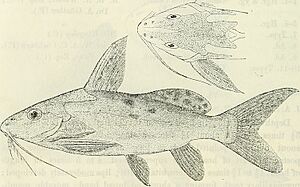Synodontis robbianus facts for kids
Quick facts for kids Synodontis robbianus |
|
|---|---|
 |
|
| Conservation status | |
| Scientific classification | |
| Genus: |
Synodontis
|
| Species: |
robbianus
|
The Russet Synodontis (scientific name: Synodontis robbianus) is a type of upside-down catfish. It lives in the rivers of Nigeria, specifically the Cross and lower Niger Rivers. This fish was first officially described in 1875 by a scientist named John Alexander Smith. The name robbianus honors Rev. Alexander Robb, a Scottish missionary who helped collect the first samples of this fish.
Contents
What Does the Russet Synodontis Look Like?
Like all Synodontis fish, the Russet Synodontis has a strong, bony head. This head protection goes all the way back to its first fin spine. It also has a special bony bump on its head called a humeral process. The shape and size of this bump help scientists tell different Synodontis species apart. For the Russet Synodontis, this bump is rough and has a ridge on its lower edge. It is about 1.5 to 2 times longer than it is wide.
Its Mouth and Whiskers
This fish has three pairs of barbels, which are like whiskers. One pair is on its upper jaw, and two pairs are on its lower jaw. The upper jaw barbels are long and straight. They have a wide base and can be about 1.25 to 1.5 times the length of the fish's head. The outer pair of lower jaw barbels is almost twice as long as the inner pair. The outer barbels have medium-sized branches, while the inner ones have smaller, secondary branches.
Fins and Tail
The front edges of the dorsal fin (on its back) and pectoral fins (on its sides) are stiff spines. The dorsal fin spine is slightly curved and smooth on the front. It has a jagged edge on the back. This spine is about two-thirds to three-quarters the length of the fish's head. The rest of the dorsal fin has seven soft rays. The pectoral fin spine is a bit longer than the dorsal spine. It has jagged edges on both sides.
The adipose fin, a small fleshy fin near the tail, is about 2.5 to 3.5 times longer than it is deep. The anal fin, located on its underside, has three or four unbranched rays and eight or nine branched rays. The tail, or caudal fin, is deeply forked, meaning it splits into two parts. The upper part of the tail is longer than the lower part.
Teeth
All Synodontis fish have a special pad of teeth on the very front of their upper jaw. This pad has several rows of short, chisel-shaped teeth. In the Russet Synodontis, this tooth pad is short and wide. On its lower jaw, the teeth are attached to flexible, stalk-like structures. These teeth are often described as "s-shaped" or "hooked." The number of teeth on the lower jaw helps identify the species. The Russet Synodontis usually has about 15 to 20 teeth on its lower jaw.
Color and Size
The body of the Russet Synodontis is pale brown. It has darker brown blotches or spots all over. Its belly fins and anal fins are dark. The dorsal fin and tail fin are lighter in color. Young fish have a light stripe on each side of their snout. They also have dark bands across their dorsal, anal, and tail fins.
The largest Russet Synodontis ever measured was about 13.8 centimeters (5.4 inches) long. Generally, female Synodontis fish tend to be a little bigger than males of the same age.
Where Does the Russet Synodontis Live and What Does It Do?
In the wild, the Russet Synodontis has only been found in the Cross and lower Niger Rivers in Nigeria. It lives in streams and lakes. This fish eats very small organisms called plankton, dead plant and animal matter (detritus), and plants.
Special Abilities
The Russet Synodontis can breathe air! This is a special ability that helps it survive in water with low oxygen levels.
Life Cycle and Reproduction
Scientists don't know much about how most Synodontis species reproduce. However, they have found eggs in female fish. It's thought that these fish lay their eggs during the flooding season. This usually happens between July and October. During spawning, pairs of fish might swim together. The young fish grow very quickly in their first year. After that, their growth slows down as they get older.


